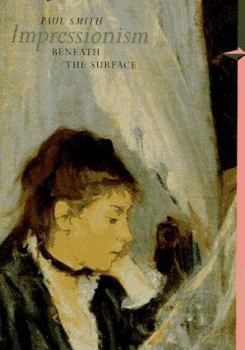Impressionism Beneath the Surface (Perspectives)(Trade Version)
Select Format
Select Condition 
Book Overview
The art of the Impressionists is loved by experts and nonexperts alike. Smith reexamines this popular group of artists in light of recent scholarship on the social context of late 19th-century France.... This description may be from another edition of this product.
Format:Paperback
Language:English
ISBN:0810927152
ISBN13:9780810927155
Release Date:January 1995
Publisher:Prentice Hall
Length:176 Pages
Weight:1.01 lbs.
Dimensions:0.5" x 6.5" x 9.3"
Customer Reviews
2 ratings
The Social Environment In Which Impressionism Began
Published by Thriftbooks.com User , 18 years ago
Paul Smith defines Impressionism in terms of the artists' reaction against the "dishonesty" of salon painting and their eagerness to embrace a new way of seeing. Focuses on five approaches: Manet and the artist as flaneur - a new way of looking; Women painters and how women saw themselves as the object of men's gaze; Monet and the exploration of sensation through close attention to light quality; Pissaro's political vision; and Cezanne and the Problem of form. The introduction is valuable in positioning how these painters saw themselves and what they were attempting to do, in the context of rising bourgeois taste, the scientific investigations of color theory and making themselves relevant to the art world of late 19th century France. They were not isolated but were part of a very active interface of art critics (Baudelaire) researchers (Chevruel) and the public acceptance of their work (Durand-Ruel). A very good overview of five different social influences on the artists. The early impressionists seem preoccupied with the concept of sensation, maybe because it was the point around which they hung their dissatisfaction with the art world of the time. They talked a great deal about "sensation" in conversations and letters, always didactically but really they were exploring. Eventually Impressionism seems to have run out for most of them but it played a vital role in forming a new vision of what role art played in society, which the public eventually bought into. Brief bibliography.
Impression down below
Published by Thriftbooks.com User , 23 years ago
If we look at IMPRESSIONISM: BENEATH THE SURFACE, we find an art with more going for it than a permanent record of how atmosphere and light change over time. The word comes from Claude Monet's pioneer "Impression, sunrise 1873," where we also find landscapists Eugene Boudin- and Johan Barthold Jongkind-type boldly painted nature from having sketched one's first impression, at one moment in time, on the spot and outside, for strong rivalry to the age-old road to artistic success by meeting carved-in-stone standards based on conservative, classical training, as in Jean-Francois Millet's divinely ordered "Autumn" praising the dignity of labor. It meant painting moments of one's own experience, as in Monet's "Women in the garden," as the way real people really looked through sharply contrasted dark and light under harsh summer sunlight so that the viewer also knew what went into getting the painting done, not as Marc Charles Gabriel Gleyre's "Minerva and the three graces," with ideal types under studio light gently going from light into shade and hiding how the painter got the painting to end up looking that way. It also made for a very personal art that was actually not so spur-of-the-moment as it seemed: Monet told American painter Lilla Cabot Perry not to paint the world as events and objects but as patches of color. But what with years of seeing things as things, Impressionists had to change their usual way of looking, which they did by studying both aesthetic and scientific theories and Japanese sources. I particularly like where the author talked about the successes with this retrained way of looking by Paul Cezanne, whose completely different style my sculptress mother loved and my artist sister still does: he painted nature in color patches, with unusual perspective and without lines, so he flattened the background and foreground with a back apple looking quite big in comparison to front apples and tilted the table top in "Still life with plaster." He put nature's organizing color by contrasts and relationships into "Park of the Chateau Noir," with complementary and nearcomplementary side by side. I also like Paul Smith's specific examples from Camillo Pissarro's art: his local colors showed light changing normal hues, as in "Cotes Saint-Denis," with everything touched by the silvery autumnal light made from warm sunlight and sky blue toplight; that same blue toplight colored "The shepherdess," but without sunlight making it through the painting's thick tree growth. In "Young peasant girl drinking coffee," the sitter's face reflected the green from the grass and trees outside her window. The anarchist painter also said that art not coming out of real experiences or looking at the real world was actually escapism. It is easy to see where Impressionist art could be non-escapist what with new ways of interpretation: anthropological, feminist, psychoanalytical, and social-historical ways, of which the book has especially telling examples of how a






